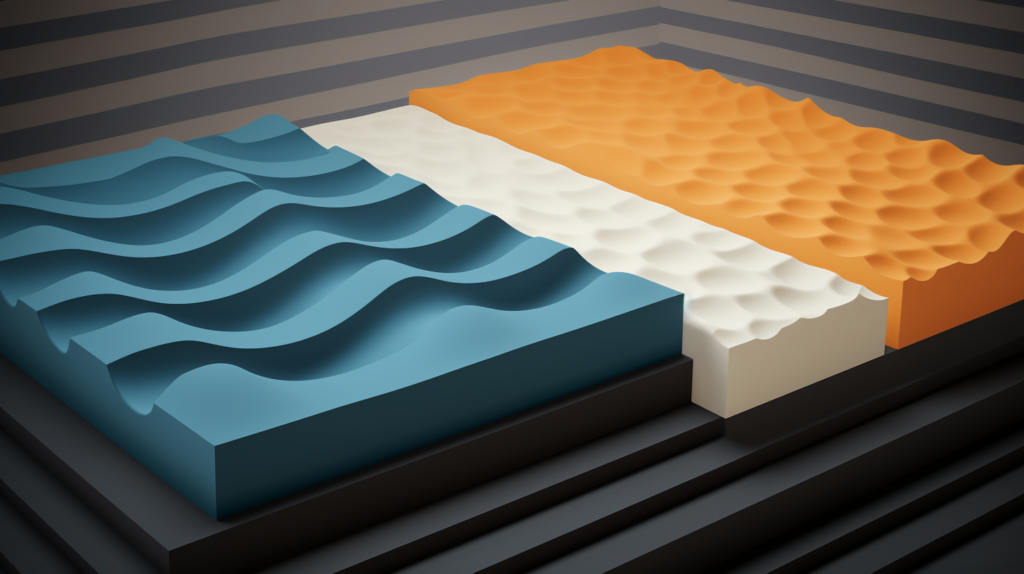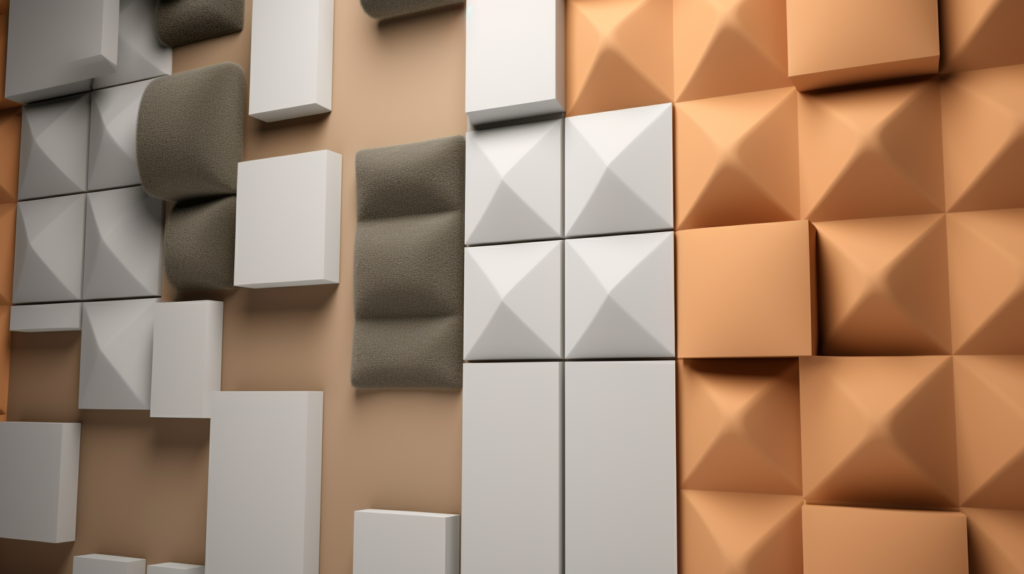Imagine sitting in your home office, ready to dive into a crucial project, when suddenly the blaring horns of city traffic or the relentless chatter of your neighbors shatter your focus. Sounds familiar? You’re not alone.
In today’s fast-paced world, noise pollution has become an invisible enemy, invading our personal spaces and affecting our well-being.
While the clamor of modern life feels inescapable, there’s a secret weapon that’s gaining popularity for its ability to bring back the peace we all crave: soundproof foam. It’s more than just a trend; it’s a lifeline in our increasingly noisy world.
So, if you’re keen to reclaim your peace amid the cacophony, you’ve come to the right place. Let’s dive in to explore the ins and outs of soundproof foam and how it could be your silent guardian in a noisy world.
Why Is Soundproofing So Important Today?

In an era where our lives are constantly inundated with noise—from the ceaseless clamor of city streets to the cacophony of digital notifications—soundproofing has emerged as a vital consideration for mental and physical health.
If you’ve ever lived near a construction site or a busy highway, you know how intrusive noise can be.
Beyond mere annoyance, noise pollution has been linked to a multitude of health concerns. Various studies have shown that long-term exposure to high noise levels can result in stress, impaired cognitive function, and sleep disturbances.
It goes even further, with some research suggesting a link between chronic noise exposure and cardiovascular issues like hypertension and heart disease.
The rise in remote work has made soundproofing even more critical. Many of us have experienced the frustration of trying to focus on a task while contending with distracting noises.
Whether it’s a lawnmower outside, children playing, or even the sound of a television in another room, these noises can significantly impact productivity.
Therefore, the need for effective soundproofing solutions has become a pressing issue, not just for tranquility but for long-term well-being and work efficiency.
Given this wide range of applications—from improving work-from-home environments to enhancing mental well-being—soundproofing has grown from a specialized requirement into a mainstream necessity.
What Exactly Is Soundproof Foam?

When we delve into the world of soundproofing, a term that frequently arises is “soundproof foam.” But what exactly does this mean? Often, people confuse soundproof foam with acoustic foam, but they serve very different purposes.
Soundproof foam is engineered to act as a barrier that prevents the transfer of sound between different areas. It is designed to be dense and thick, qualities that contribute to its effectiveness.
When installed properly, it can make a significant difference in reducing noise transfer.
In contrast, acoustic foam is lighter and serves to improve the quality of sound within a specific space. It does this by reducing echoes and reverberations.
Acoustic foam is not designed to block sound from entering or leaving a room but rather to enhance the sound quality within that space.
The difference between the two is not just in their material composition but also in their function. While acoustic foam is often used in recording studios to enhance sound quality, soundproof foam is more versatile and can be used in a variety of settings.
It’s ideal for spaces where you want to prevent sound from entering or leaving, such as a home office, a bedroom, or even a home theater.
What Materials Are Used To Make Soundproof Foam?

The effectiveness of soundproof foam largely depends on the materials used in its construction. Unlike acoustic foam, which is often made from polyurethane or melamine, soundproof foam is typically constructed from denser materials like mineral wool and fiberglass.
These materials are chosen for their ability to effectively block sound waves. Mineral wool, for example, is made from molten rock or slag that is spun into fibers and then compressed into mats.
This density makes it highly effective at absorbing and blocking sound.
Fiberglass, another common material in soundproof foam, is made from fine glass fibers and is also excellent at absorbing sound. It is often used in industrial applications but is equally effective in residential settings.
Both of these materials have distinct qualities that make them effective for soundproofing. Their density and fibrous structure create a barrier that sound waves find difficult to penetrate, thus reducing the amount of noise that passes through them.
Importantly, both materials are also fire-resistant, adding an extra layer of safety.
How Does Soundproof Foam Work?

To fully appreciate how soundproof foam works, it’s essential to understand some basic principles of sound. Sound travels in waves, and these waves require a medium like air, water, or a solid substance to move.
When these sound waves hit a barrier, several things can happen: they can be absorbed, reflected, or transmitted through the barrier.
Soundproof foam aims to absorb and reflect these sound waves, reducing the amount of sound that gets transmitted from one side of the foam to the other.
The dense, fibrous materials in the foam trap air and sound within their structure, either reflecting the sound back to its source or absorbing it to dissipate its energy.
Factors such as the density, thickness, and type of material all play a role in determining how effective the soundproof foam will be. Generally speaking, the denser and thicker the foam, the better it will be at soundproofing.
However, there are limits to this; past a certain point, increasing density and thickness will yield diminishing returns.
What’s The Difference Between Soundproofing And Acoustic Treatment?

In the world of sound management, two terms are often used interchangeably but incorrectly: soundproofing and acoustic treatment. So, what distinguishes one from the other?
At its core, soundproofing is about creating a barrier that prevents or minimizes the transfer of sound between different spaces. It’s about isolation and containment.
Acoustic treatment, on the other hand, doesn’t stop sound from entering or leaving a room; it manipulates how sound behaves within that space. This is achieved through materials that absorb, diffuse, or reflect sound to improve its quality.
Acoustic treatment is widely used in recording studios, home theaters, and other environments where sound quality is of utmost importance.
Thus, it’s crucial to identify what exactly you’re looking to achieve: Do you want to keep sound out, keep it in, or improve the sound within a space?
Your goals will determine whether you need soundproofing, acoustic treatment, or possibly both.
Understanding this distinction is essential because it affects your choice of materials and installation methods. Using the wrong materials for the wrong purpose will not only waste time and money but also result in ineffective sound management.
How Effective Is Soundproof Foam For Noise Reduction?

One of the most common questions surrounding soundproof foam is: How effective is it, really? The answer depends on various factors, including the quality of the foam, the frequency of the noise you’re trying to block, and how well the foam is installed.
High-quality soundproof foam, especially those made from mineral wool or fiberglass, can be incredibly effective for blocking everyday noises. These could range from street noise to loud conversations from an adjacent room.
However, for extremely low-frequency sounds like the rumbling of a subway or the roar of an airplane, more advanced solutions may be required.
Proper installation is also crucial. Soundproofing is only as effective as its weakest link. Gaps or cracks in the installation can significantly reduce the foam’s effectiveness.
Therefore, it’s often advisable to consult with professionals for the best results.
What Are The Pros And Cons Of Using Soundproof Foam?

While soundproof foam has its merits, it’s important to understand its limitations as well. Let’s start with the pros. One of the most significant advantages is its ease of installation.
For those who are handy, installing soundproof foam can be a straightforward DIY project, saving on labor costs.
Another benefit is the foam’s versatility. It can be used in a multitude of settings, from home offices to commercial spaces like restaurants or gyms, offering a flexible solution for various noise issues.
However, it’s not a one-size-fits-all solution. One of the cons is that it might not be sufficient for blocking extremely loud or low-frequency noises.
For such cases, more robust solutions like mass-loaded vinyl or decoupling techniques may be required.
Additionally, while soundproof foam is generally less expensive than some other soundproofing options, costs can add up, especially for larger spaces. Consumers should be aware that while it’s a more budget-friendly option, it still represents a financial investment.
What Are Some Alternatives To Soundproof Foam For Noise Reduction?

When considering noise reduction options, it’s wise to explore alternatives to soundproof foam. So, what else is out there? One popular alternative is mass-loaded vinyl, a flexible material known for its ability to block sound effectively.
But even as an alternative to soundproofing foam, mass-loaded vinyl has very limited soundproofing capabilities as compared to soundproofing foam.
At Burton, we have a new soundproofing panels which uses rubber and felt to help soften the sound and at the same time do excellent soundproofing against airborne noises.
How Do Polyester Acoustic Panels Compare?

Many times, polyester acoustic panels are pitted against soundproofing foam but they serve a different purpose. Unlike soundproof foam, which is designed to block sound, polyester acoustic panels are geared toward improving the acoustic quality within a room.
These panels are excellent for reducing echoes and enhancing sound quality but are not designed for soundproofing. Therefore, if your primary concern is blocking sound from entering or leaving a space, polyester acoustic panels may not be the most suitable choice.
How Do You Install Soundproof Foam For Maximum Effectiveness?

The installation of soundproof foam is a critical step that can make or break its effectiveness in reducing noise. To start, you’ll need to identify the areas most susceptible to noise transfer.
This usually includes walls that are adjacent to noisy areas, but don’t forget about ceilings and floors, as sound can travel through them as well.
Next, prepare the walls where the soundproof foam will be installed. This may involve removing any existing wall coverings and performing a thorough cleaning to ensure that the foam adheres correctly.
A clean, dry surface is essential for effective installation.
Before proceeding, measure the area carefully to determine how much foam you will need. This is crucial because insufficient coverage will compromise the foam’s soundproofing capabilities.
It’s often a good idea to purchase a bit more than your measurements suggest, just in case.
Once the surface is prepared, it’s time to install the foam. Unlike acoustic foam panels that can sometimes be mounted directly onto a wall surface, soundproof foam often needs to be integrated into the wall structure for maximum soundproofing.
This usually involves attaching the foam between the wall studs.
In some instances, you may also need to add a layer of drywall over the foam for added effectiveness. The foam should be cut to fit snugly between the studs, leaving no gaps or spaces where sound could seep through.
Depending on the type of foam and your specific needs, an adhesive may be required to secure it in place. Always consult the manufacturer’s guidelines for specific installation instructions.
Once the foam is securely installed, a layer of acoustic sealant around the edges can offer an added layer of soundproofing. This helps to seal any minor gaps or cracks where sound might escape.
If this sounds like a lot to handle, especially if you’re not accustomed to DIY projects, professional installation might be the best route. Experts can ensure that the foam is installed correctly and efficiently, maximizing its soundproofing capabilities.
Should You Choose Soundproof Foam For Your Noise Reduction Needs?

The decision-making process for selecting the right soundproofing material is multi-faceted. Factors like the specific type of noise you’re dealing with, budget considerations, and long-term needs all come into play.
Soundproof foam presents itself as a versatile and cost-effective solution that is well-suited for a range of applications. For environments with moderate noise levels, soundproof foam often strikes an excellent balance between cost and performance.
One advanced strategy for enhancing the effectiveness of soundproof foam is the addition of resilient channels to the wall studs. This supplementary step augments the foam’s performance by creating an air gap that provides additional isolation against structure-borne noises.
However, this approach requires the walls to be opened up to expose the wall studs, which may not be feasible in all situations.
If opening up walls isn’t an option, an alternative solution exists: soundproofing panels. These can be installed directly onto the walls and offer effective airborne soundproofing.
While not as effective against structure-borne noise as foam with resilient channels, they still provide a substantial level of noise reduction and are easier to install.
Conclusion
In today’s noisy world, where peace and quiet have become luxuries, the quest for effective soundproofing solutions is not just a matter of comfort—it’s essential for our well-being.
As remote work becomes the norm and our homes transform into multi-functional spaces, the need for noise reduction has never been greater.
Soundproof foam emerges as a versatile, cost-effective option that suits a broad range of noise-reduction needs. From blocking everyday distractions to enhancing work productivity and even contributing to better mental health, its applications are vast.
While it’s not a one-size-fits-all solution, it often offers the best balance of cost and effectiveness for moderate noise levels.
But like any other product, soundproof foam has its limitations and may require supplementary measures like resilient channels or alternative options like soundproofing panels for specific scenarios.
Understanding the nuances between soundproofing and acoustic treatment, as well as the different materials and installation methods, can go a long way in choosing the right solution for your needs.
So whether you’re trying to create a focused workspace, a peaceful sanctuary, or simply a quieter living environment, soundproof foam offers a practical solution that addresses a growing modern-day challenge.
With noise pollution on the rise, investing in soundproofing is not just a choice—it’s a necessity.
